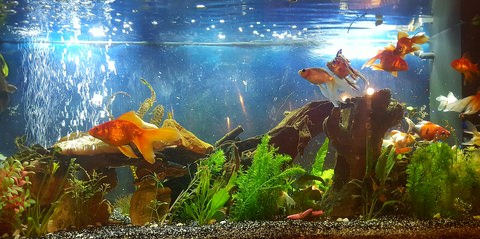| Back to Back Issues Page |
 |
|
The Goldfish Gazette, Issue #093 Water Change Tools September 29, 2021 |
Goldfish Care TipsA Free Monthly Resource For Goldfish Enthusiasts In This Issue Regular water changes have the biggest impact on the health and growth of a Goldfish, but managing large volumes of water safely needs good planning and the right tools for the job. Water Change Tools
As to the frequency, volume and reasons for water changes, that is as inconsistent as it has always been. Water Change FrequencyFor newer readers, I will quickly repeat the process I have covered in earlier e-Zines.Unless you use a water test kit to test your water parameters, you are only guessing what your water change frequency or volume should be. Your water test kit tells you when the pH drops to 6.00, and/or your nitrates have reached 30 ppm (parts per million). You may be surprised how quickly this occurs, even in a large aquarium. Some websites warn about changing too much water because it will shock your fish. As long as the pH of the fresh water is higher and water temperatures are close, your fish won't be harmed. I have never seen “shocked” fish after my usual large water changes (usually 90%). As soon as fresh water starts flowing into the aquarium, my fish start foraging for food. Water Change ToolsThe problem with choosing Goldfish as pets is you quickly find out that they require large aquariums.This poses a few problems such as how to make frequent large water changes quickly, easily and safely. Recently I recommissioned two 120 liter aquariums, using one for 12 under-size Celestial juveniles I need to feed heavily. As I knew I would need to change their water at least weekly, probably more often as they got bigger, I needed to assemble together some equipment that would make the job easier and quicker. Filter: I installed a large sponge filter. I consider a filter a vital part of a water change regime, as it eliminates ammonia and nitrites so extending the time between water changes. Siphon hose: The next most important tool. I fitted a canister filter intake tube to mine cut to length so it leaves two inches (52mm) of water in the bottom of the aquarium. The hose is long enough for me to send the water down a storm water drain outside. A good option for those not wanting to assemble something themselves is the Python siphon that comes with a gravel cleaner and tap fittings to refill the aquarium. It comes in 25, 50, 75 and 100 foot lengths. Any siphon you use should be long enough so the hose can be taken outside or to a bath or shower. Using buckets is just too hard for larger aquariums. 70L plastic bin: As I have a heater in the Celestials, my tap water temperature is presently 10-12oC colder than the aquarium. I have to fill the bin with fresh water from a garden hose, add Stress Coat for chlorine, then add hot water to equalize the temperatures. I then use an aquarium water pump to transfer the water to the aquarium (twice). Water Change DangersMany Goldfish have been killed or severely injured during siphoning. Always have some sort of grill on your siphon intake big enough so your fish can overcome the vacuum that is created.Your siphon should leave enough water in the aquarium so your fish will survive if you become distracted. Never ever leave a refilling aquarium (when using the siphon hose for refilling). We have all been distracted by the phone ringing, visitors etc. and the sound of splashing water is terrifying. I would suggest purchasing a water level warning device which has saved me on numerous occasions. Comments? Ideas? Feedback? I'd love to hear from you. Just reply to this e-zine and tell me what you think, or what topics you want covered. Next Month's Topic Juvenile Feeding for Growthwww.facebook.com/aboutgoldfish |
| Back to Back Issues Page |
